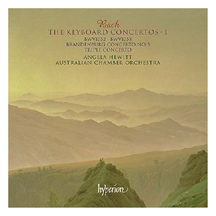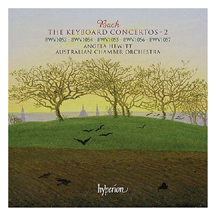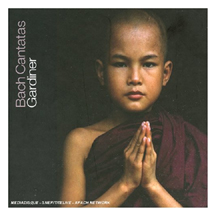|
You are reading the older HTML site
Positive Feedback
ISSUE
21
Lots o' Bach
The first impression I got from these recordings remained the dominant one as I listened through them: the piano really lets these be keyboard concertos, lets us hear a voice that is more dynamically and tonally distinct from its accompanying forces than a harpsichord would be. And, I should add, not a piano that tries to ape a harpsichord: Hewett plays the piano as a piano, albeit with little or no peddle work. We who are accustomed to piano concertos find this very natural, unless we have learned not to. I love this music on harpsichord and period instruments; but there is no denying the different kind of musical excitement and pleasure that comes from hearing the keyboard ring out with the force and clarity of a modern piano. A harpsichord being a plucked instrument, one would think it would be fairly distinct from bowed strings, and of course it is. But Hewett on the piano gives us a different kind of distinctiveness. It does not make the piano the better instrument for this music, anymore than Hewett's piano is better than Kenneth Gilbert's harpischord on Couperin. But it makes it legitimate, which is quite a victory these days in the frequent squabbles over historical correctness. And more important, it makes it wonderful.
I have not heard Periah's versions, brought out
to ride on the success of his very fine Goldberg Variations CD on piano,
so I can't make the comparison you may be looking for. But if you have been
listening to Hewett's continuing Bach cycle, you won't need that. You already
know that this pianist can interpret the baroque aesthetic by means of the piano
in a way that persuades us it can be as natural and compelling a vehicle as the
instrument this music was written for. And some my even come to feel The Australian Chamber Orchestra is a fine match for Hewett's piano: light, warm, and husky. And there is a harpsichord plucking away in the background as continuo! As Hewett explains in her program notes (eloquent and informative as ever), "On this recording we have done something slightly unusual (although certainly it has been done before). To better distinguish between the solo and tutti passages, we have decided to use a harpsichord in its traditional role as continuo. The baroque orchestra is not complete without it, and there is no reason why it shouldn't be part of a modern-day recording, even when the piano is used as the solo instrument…When used sensibly, the harpsichord adds the appropriate colour to the orchestra without interfering in any way with the solo part." How can we help but feel comfortable in her hands?!
The cantatas in this album deal with the separation of Christ from his disciples after the glory of the resurrection. As a result, the fresh energy I noted in the first two volumes re-released in the Gardiner Bach Cantata series is not what comes to mind here. One reviewer attributed the change in mood to the performers' likely exhaustion because of the weekly performance schedule laid out by Gardiner! Having had at first hand a taste of what life is like when in the hands of the son of God, these enlightened but desperate men must now essentially return to the lives the rest of us live, with only faith and hope standing between them and a world without ultimate meaning. This is sorrowful, poignant, but also valiantly hopeful music. To render it effectively, performers must maintain a commanding pace and get the details right, else the music will sink into a mire of melancholy. All of which I am happy to report Gardiner and his forces do exceptionally well. Though I am not as married to period instruments as I once was, I am grateful for their comparative lightness and clarity of texture in this music. I am also delighted to hear the different sounds of the two venues used in this set, the first the Schlosskirche in Altenburg, Germany, the second in St. Mary's, Warwick, England. The music system used for this audition is by Audio Note and included the new Audio Note CDT 2 II transport and Dac 4.1 Balanced, M6 preamplifier, Neiro 2A3 monoblocks, and Audio Note cabling.
|

 J.S. Bach, Keyboard Concertos. Two Volumes.
Angela Hewett, piano. Australian Chamber Orchestra, Hyperion.
J.S. Bach, Keyboard Concertos. Two Volumes.
Angela Hewett, piano. Australian Chamber Orchestra, Hyperion.  that
because it is the piano that is more familiar to us as modern listeners and the
harpsichord just a bit precious and exotic, we are actually getting the music
more directly through the modern instrument. I don't push this point – and it
may make no sense at all to early music aficionados for whom the harpsichord has
become the keyboard norm. But it's a point worth belaboring.
that
because it is the piano that is more familiar to us as modern listeners and the
harpsichord just a bit precious and exotic, we are actually getting the music
more directly through the modern instrument. I don't push this point – and it
may make no sense at all to early music aficionados for whom the harpsichord has
become the keyboard norm. But it's a point worth belaboring. J.S. Bach, Complete Cantatas, Volume 24. John Eliot Gardiner. English Baroque
Soloists. Monteverdi Choir. Por Deia Soli.
J.S. Bach, Complete Cantatas, Volume 24. John Eliot Gardiner. English Baroque
Soloists. Monteverdi Choir. Por Deia Soli.